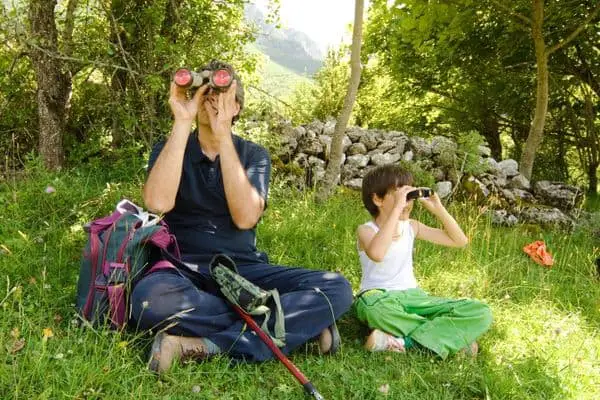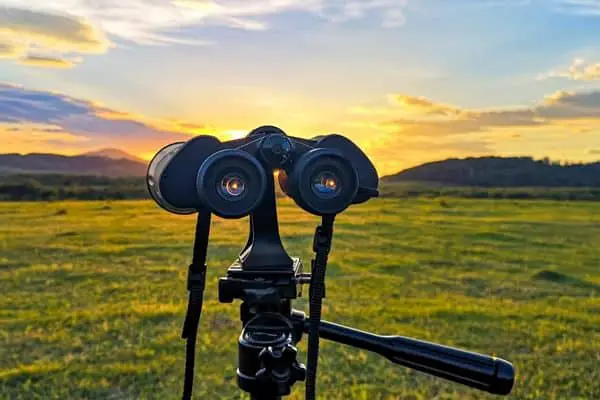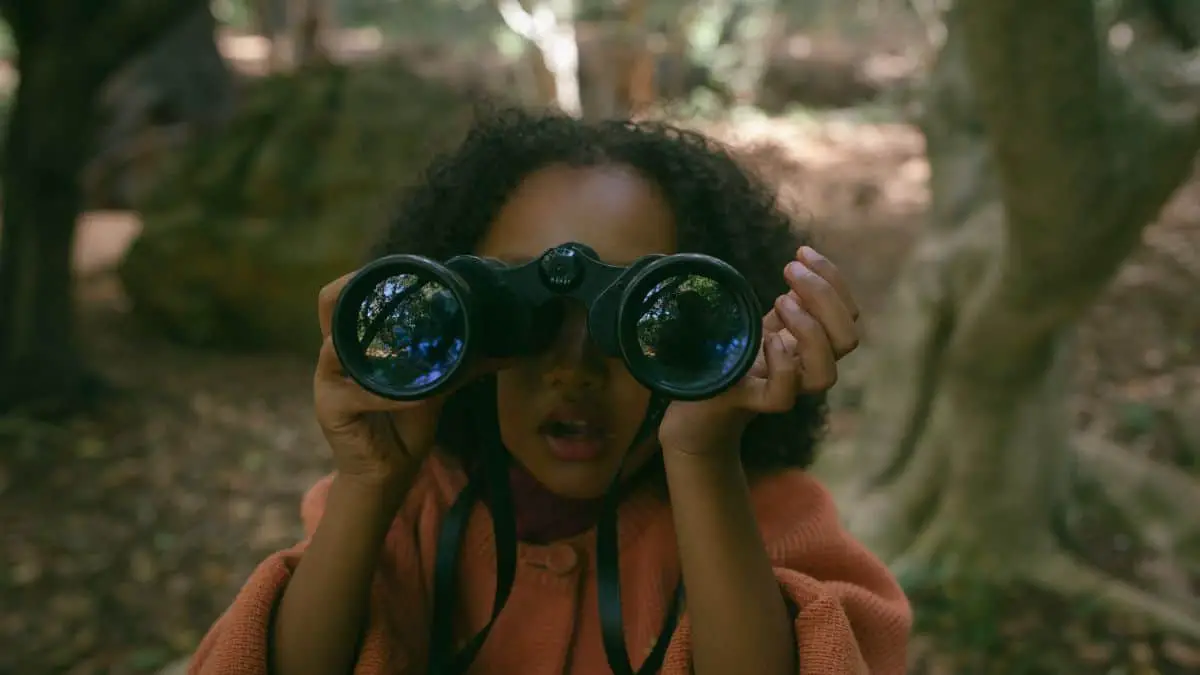How To Use Binoculars (Including Parts and How To Adjust)
Thinking about birding or stargazing? Then you probably need a good pair of binoculars to give you that unmatched viewing quality that takes your breath away.
But do you know how binoculars work? How can you effectively use them and be amazed by the spectacular show nature has to offer?
Binoculars are viewing instruments that allow you to see distant objects without moving closer. It has two telescopes, one for each eye, and is positioned side by side on a single frame to form a pair of binoculars.
Today we’ll also look at the different parts of binoculars and how they work.
Well, let’s get right into it.
Related Articles: Best Telescope for Land Viewing and Best Computerized Telescope for Beginners
How To Use Binoculars | Hold and Focus Tips
Before we get to the details of how to actually use binoculars, you first need to know how to hold one properly for the best functionality. Holding your binoculars well also improves the overall scenery focus and magnification.

1. How To Hold Your Binoculars
To be clear, there’s no one way of holding a pair of binoculars. The important thing is that you ensure your hands are comfortable since viewing sometimes lasts for long hours.
If you have medium or regular-sized binoculars, you can hold them separately by wrapping your hands over the different barrels. If your other hand is occupied, you can hold them with just one hand.
The basic goal is to generate steady pictures that are sharp and clear when magnified.
Hint: You can also use a tripod to hold your binoculars if you plan to go for a long viewing session. A stable tripod will help you get better and steadier viewing at high magnification.
2. How Do You Focus Your Binoculars?
One of the hardest challenges you could have if you are just starting to understand how to use binoculars is making an item look larger and closer while still maintaining clarity.
That said…
- It’s crucial to align the binoculars’ barrels with the distance between your two eyes before concentrating. You will know the barrels’ distance is accurate once you notice the two separate circular frames merge into one circle without dark edges in your view.
- Next, choose an object to concentrate on. To practice correctly, make sure you are standing far enough away. Keep both eyes wide open while simultaneously rotating the focus wheel for clear focusing.
- First, shut your right eye and move the focus wheel while using just your left eye for vision. Next, close the left eye while keeping the right eye open to adjust the focus wheel.
- The diopter ring must be adjusted instead of the focus wheel while concentrating with the right eye open. (This goes for binoculars with a diopter ring on the right barrel and vice versa.)
- Adjust the wheel until your right eye can see the selected target well. Then, with both eyes open, check to see if the subject is well-defined and sharp.
- If not, repeat the entire process and make little modifications until you can see it properly.
It might take a little while to get used to, but it will come naturally after a few tries in the field.
Hint: Note down the reading on the diopter ring after you find the perfect view and magnification when setting up. This will save you a lot of time next time you want to use your binoculars after storing or helping a buddy with them. The same also goes for the focus wheel.

What Are the Main Parts of Binoculars?
Let’s now see the main parts of binoculars and how they work to give you that fantastic view when birding or sightseeing.
1. The Objective Lenses
The objective lenses are a set of lenses placed immediately in front of the eyepieces at the other end of the barrel (where the light gets in). They are always on the opposite end of your eyes.
Objective lenses gather the available light from the environment and focus it on the eyepiece so the viewer can clearly see the subject(s).
They are always bigger than eyepiece lenses to allow them to gather as much light as possible for clearer, sharper, and closer view magnification.
2. The Eyepiece Lenses
Eyepiece lenses are slightly smaller than the objective lens since their only function is to magnify the light brought in and are also where you put your eyes to focus on a view.
The eyepiece lens’s function is to magnify the image after the objective lens focuses the light captured from the environment onto it.
3. Prisms
The prisms are one of the most essential parts of your binoculars.
They are usually placed between the objective lens and the eyepiece to help you correct the inverted picture.
4. The Focus Wheel
The focus wheel is located between the two binocular barrels and is used to move the inner lenses to bring better focus to the object.
When adjusted and left at the center, it’s said to be at center focus. If you want to focus on individual barrel focus, you can shift it to the right or left until you attain a clear picture.
5. The Diopter Adjustment Ring
The diopter ring is an adjustable ring located beneath the eyepiece lenses. It adjusts the independent focus of each eyepiece to the user’s needs.
Most binoculars come with a diopter ring on the right eyepiece, but others have it on the left.
6. Chassis
This is the binoculars’ external casing that holds all of the components mentioned above together.
Depending on the material used on the chassis, your binoculars’ weight and longevity may significantly vary.

How To Adjust Your Binoculars’ Magnification
Binoculars are usually represented with a pair of numbers in their naming, i.e., 8×40, 10×25, etc.
The first number shows the magnification level, while the second represents the objective lens’s diameter. Objective lenses with larger diameters collect more light than their smaller counterparts, providing sharper and more detailed photos.
To get better outcomes, you must correctly magnify your subject. This will only be possible if you get the right gear, whether you are hunting, birding, stargazing, or simply viewing landscapes.
You have to be aware of the correct magnifying techniques.
Why Are Binoculars Important?
1. Handy Hiking Gear
Hikers use binoculars to observe nature’s beauty from a long distance away while on mountain tops, peaks, and whatnot.
Additionally, they can help you identify other hikers from far away if you lose each other and find trails if you are just lost altogether.
2. For Security Reasons
New, modern binoculars with night vision enable security personnel such as evening guards to see and scan for threats in the dark.
These are pretty effective when trying to stay vigilant on night-time criminal activities.
3. For Viewing Distant Performances
If you are a sport or event goer, you probably understand the hassle of a crowded arena when trying to get a good view.
Luckily, with a pair of binoculars, you can zoom in on the live stage/pitch and watch all the action unfold before your eyes like in a live TV stream.
No more need to push and elbow others for front-row seats.
4. Helps Avoid Wild Attacks
If you’re camping in the woods, you need to be on the lookout for potential wildlife visitors and keep an eye out for them.
A pair of binoculars will help you see the critters from a distance and respond appropriately in case of danger.
Frequently Asked Questions
1. How Do You Clean Binoculars?
One of the best ways of cleaning your binoculars is by using a soft camel brush or a blower. When wiping the lenses, avoid using your breath as it will only fog them and cause dust particles to be trapped on the glass.
Make sure that dust is blown away by the use of a blower.
Also, always use a clean fiber lens cloth to reduce the occurrence of scratch marks on the lens. After cleaning, ensure you store the binoculars away in a zipped plastic bag to avoid dust buildup.
You can also use tissues, toilet paper, or paper towels, as any fibrous cloth might leave a scratch-causing residue.
2. How Do Night Vision Binoculars Work?
Night vision Binoculars aid in achieving clear nighttime vision. During the night, When the stars and moon shine through your lenses, they absorb extra light and cause the image to be illuminated.
A night vision binocular has three major components: the photocathode, photomultiplier, and phosphor screen.
A photomultiplier converts photons to electrons when the faint night light travels through the lens and reaches the photocathode layer (light-sensitive part). The electrons then strike the phosphor screen, producing little flashes of light.
Electrons, which are far more abundant than photons in binoculars, generate significantly brighter light, allowing you to see a more brilliant picture even at night.







